As of March 2021 the ARC-1.1 has been discontinued.
Quite simply, there is no other recording channel strip on the planet that has the versatility of the ARC-1.1. What you have here is a mic/line preamp, parametric equalizer and compressor/limiter that can be used in conjuction as a recording channel or, accessed as completely separate elements. The ARC is not just one piece of kit but multiple pieces bundled into one chassis with a clever relay routing system so you can assign each element to the main signal path or to externally accessed I/O.
The signal path of the ARC utilizes high end audio amplifiers from Analog Devices which have been selected for their wide frequency response and naturally warm sound. The mic preamp input uses our Class A BE40 amplifiers to provide impressively low noise at high gains. The output section of the ARC includes a switchable steel core transformer that adds a more vintage sound if so desired. (All componentry is "through hole", there is no sub-minature surface mount circuitry in this unit).
The extensive equalizer section includes a variable high pass filter, two parametic mid bands covering the full audio spectrum and bass/treble shelving bands. The compressor is a clone of our famous SOC-1.1 opto design and attached to that is a very fast FET limiter. Even more powerful, each band of the eq can be assigned to the side chain of the compressor for frequency dependant compression effects. Read the controls and functions section below to find out more about the creative versatility of the ARC-1.1.
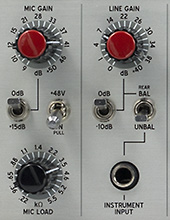 First up is the all important mic preamp. The ARC utilises the Class A BE40 high speed amplifier developed for the MA-2.2 mic preamp. The BE40 amplifiers ensure accurate transient detail reproduction and very good noise performance. Another feature is the padless input circuit with a +15dB gain boost switch instead, providing a total mic gain range of +9 to +65dB. The mic load control adjusts the mic input impedance from 200 ohm thru to 5k ohms. This control provides another means of varying the tonal quality of the connected microphone. The 48V phantom power switch features a soft start circuit to avoid thumps and bangs. A direct output of the mic preamp stage is available on the rear panel allowing use of the mic pre section whilst using the ARC in line mode.
First up is the all important mic preamp. The ARC utilises the Class A BE40 high speed amplifier developed for the MA-2.2 mic preamp. The BE40 amplifiers ensure accurate transient detail reproduction and very good noise performance. Another feature is the padless input circuit with a +15dB gain boost switch instead, providing a total mic gain range of +9 to +65dB. The mic load control adjusts the mic input impedance from 200 ohm thru to 5k ohms. This control provides another means of varying the tonal quality of the connected microphone. The 48V phantom power switch features a soft start circuit to avoid thumps and bangs. A direct output of the mic preamp stage is available on the rear panel allowing use of the mic pre section whilst using the ARC in line mode.
Next up is the line input stage which is either the rear panel balanced XLR input (with loop thru) or front panel unbalanced high impedance input. The line gain is variable from 0dB to +40dB. In addition, a -10dB pad can be switched into the balanced input to cater for those hot signals from D-A convertors. In addition to attenuating the input, the -10dB switch raises the input impedance from a nominal 20k ohms to 70k ohms which allows the driving device to freely deliver high level without undue distortion.
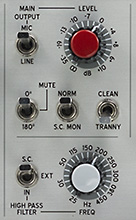 Here's where you select the mic or line input to feed the main output of the ARC. The output gain control provides +10dB of additional gain as well as acting as a fader. This control can be useful for setting the correct level into -10dBv devices such as computer sound cards. Also available here is a polarity reverse switch with mute in the centre position. Another switch selects normal output or side chain monitor, which allows you to hear what is being fed into the sidechain of the compressor section and therefore any EQ being applied.
Here's where you select the mic or line input to feed the main output of the ARC. The output gain control provides +10dB of additional gain as well as acting as a fader. This control can be useful for setting the correct level into -10dBv devices such as computer sound cards. Also available here is a polarity reverse switch with mute in the centre position. Another switch selects normal output or side chain monitor, which allows you to hear what is being fed into the sidechain of the compressor section and therefore any EQ being applied.
Next up is the clean/tranny switch. In clean mode, the audio path is direct. In tranny mode, a steel transformer is switched into the signal path introducing low frequency harmonics and providing yet another tonal variation to the signal. The high pass filter (part of the equaliser section) features variable filtering of low frequency signals from 25Hz up to 450Hz. The filter has a musical 12dB/oct slope and can be switched into the main signal path (IN), or into the sidechain (S.C.) of the Opto Compressor, or when selected to EXT, the filter is available externally via the rear EQ in/out XLR's.
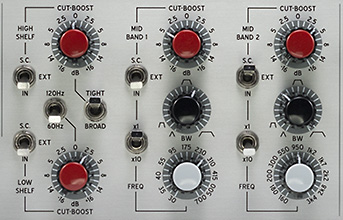 The four band parametric EQ features high and low shelving sections. The low shelf features two selectable turnover frequencies and utilises a true inductor (choke) resulting in a very tight sounding bottom end control. The high shelf offers a broad or tight shelving curve. The tight curve allows you to boost or cut the very top end without much effect to the mid band. Each section can be individually switched in to the main path (IN) or into the sidechain (S.C.) of the ARC Optical Compressor. When switched to EXT, the sections are available externally via the rear panel EQ in/out XLR's.
The four band parametric EQ features high and low shelving sections. The low shelf features two selectable turnover frequencies and utilises a true inductor (choke) resulting in a very tight sounding bottom end control. The high shelf offers a broad or tight shelving curve. The tight curve allows you to boost or cut the very top end without much effect to the mid band. Each section can be individually switched in to the main path (IN) or into the sidechain (S.C.) of the ARC Optical Compressor. When switched to EXT, the sections are available externally via the rear panel EQ in/out XLR's.
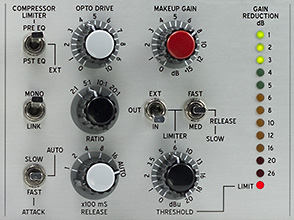 Incorporated into the ARC is a single channel version of the Buzz Audio SOC1.1 Stereo Optical Compressor and a FET Peak Limiter. The limiter/compressor combination can be set before (PRE) or after (PST) the equaliser section or out of the main path altogether (EXT). When selected to EXT, the Compressor is available for independant operation via the rear panel Comp in/out balanced XLR's.
Incorporated into the ARC is a single channel version of the Buzz Audio SOC1.1 Stereo Optical Compressor and a FET Peak Limiter. The limiter/compressor combination can be set before (PRE) or after (PST) the equaliser section or out of the main path altogether (EXT). When selected to EXT, the Compressor is available for independant operation via the rear panel Comp in/out balanced XLR's.
The opto drive control varies the amount of compression, similar to a threshold control on other compressors. Comp ratio is switched 2:1, 5:1, 10:1 or 20:1 but all ratio's feature a soft knee characteristic. Compr release time is selectable from 100 milli-seconds to 1.6 seconds and also includes an auto position which is program dependant. Three attack time settings are available, with fast being very fast for an optical type compressor. Finally, a link switch allows linking to another ARC for stereo operation. Compressor gain reduction is displayed with a 12 element bargraph display.
The fast attack peak limiter utilises a FET (field effect transistor) for the gain reduction element and the release time can be selected fast, medium or slow. The Limiter can be independantly switched into the ARC main signal path (Post EQ) or accessed via the rear Comp In/Out XLR's. It is always Post the compressor when used in combination. Although primarily designed to catch peak levels that would otherwise cause "overs" on digital recorders, the peak limiter can be used for some very heavy compression effects. Limiter action is displayed with a single LED.
The combination of the Opto Compressor with EQ-able sidechain and the output Peak Limiter give the ARC a very powerful dynamics package indeed. The peak limiter (always post the Opto compressor) has the ability to catch transients missed by the slower opto action thereby providing a near zero attack time compressor system.
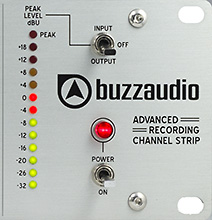 Last but not least is the meter select switch which displays on the 12 segment bargraph the input level (ie post the mic/line gain stages), or output level (what is leaving the ARC main output). The meter can also be switched off. The peak led is driven by a circuit that monitors audio level at critical points within the ARC-1.1 signal path and will light when levels exceed +20dBu. Finally a power on/off switch completes the picture.
Last but not least is the meter select switch which displays on the 12 segment bargraph the input level (ie post the mic/line gain stages), or output level (what is leaving the ARC main output). The meter can also be switched off. The peak led is driven by a circuit that monitors audio level at critical points within the ARC-1.1 signal path and will light when levels exceed +20dBu. Finally a power on/off switch completes the picture.
I've done a little work with the ARC 1.1 now and I think it's absolutely wonderful. The controls are so beautifully calibrated and seem instinctively "right".
I have a number of excellent and extremely useful plug-in EQs and compressors, but there's something about the immediacy and haptic feedback of the real thing that can't be beaten. And it all sounds so clean and full. So thank you – I look forward to getting to know the unit better over the next few years, and as budget allows, I'll invest in some more Buzz Audio products. This one will keep me going for a while, however!
Auckland, New Zeland
I just received my new ARC 1.1 and needless to say, I am very impressed with it. I’ve made my living over the last 25 years a a voice actor in the Los Angeles market, also providing audio production services for client’s world-wide. I also happen to have a bachelors degree in electronic engineering. In evaluating gear, I have a bit of a unique perspective, being able to draw upon these different skill sets.
The ARC 1.1 arrived properly packaged. Double boxed, with a custom foam insert. This may seem odd to mention, but it has been my experience that the quality and care of packaging usually follows through to the quality of unit itself. The first thing I usually do is pop off the top and have a look inside. The quality of build designer Tim Farrant has put into this is stunning. High quality metal work. Shielded toroidal transformer. Well designed linear power supply with oversized heat sinks. The functional sections each have their own PC board/module. They are tied to a relay routing system using high quality cabling. This reduces the chances of crosstalk, and if ever needed, makes repair much easier.The mic pre-amp is a transformer-less design, similar to the Buzz Audio MA 2.2 mic pre. It uses Tim’s BE-40 custom discrete amplifiers, running at higher voltage rails to ensure proper headroom in this critical stage. The rest of the sections appear to use high quality Analog Devices IC’s. It appears that Tim has chosen to use very high quality carbon pots vs. the conductive plastic variety. I was very happy to see this, as I have had many a conductive plastic pot go noisy on me, with no way to clean it.The functional sections include the aforementioned discreet class A mic pre, a separate line input section, hi pass filter, 4 band parametric eq, optical compressor, brick wall FET limiter, output section with a switchable “effects” transformer and nice bright and fast LED metering.Enough about the nuts and bolts. How does it sound?I have used/owned many channel strips over the years, and while there are some very good ones out there, I have found that I always find at least one of the functions to be lacking. Either the pre is not clean, the EQ limited or the compressor is finicky, or poor sounding. This makes most of these devices limited in their use even though you are still paying for the “not so good” parts. The Buzz Audio ARC 1.1 is the only channel strip I have used where all of the functions are not only usable, but stellar. The preamp is ultra clean without being sterile. Its also dead quiet and articulate with gobs of headroom. My Sennheiser 416 has never sounded better.The EQ section is very versatile and musical. For example, it allows you to really reach in and take out just the right amount of mud around 180, add a little presence at 3.5K and a bit of air at 12k. Control over the Q in the mid-band filters allows you to really fine tune things. The optical compressor is clean and, unless really driven, transparent. 5:1 in auto attack/release mode was just the ticket. The proprietary LED opto circuit is very fast, compared to an LA2 or even an LA3. It was able to track and control the spoken word very well, with no“lost words” due to slow release, etc. The FET peak limiter seemed to work quite well, but these days, the look-ahead capabilities of a good plug-in is hard to beat.I love the metering on this thing. While in session, i can easily glance over an know exactly whats going on. The meters are bright with well chosen ballistics. The “Tranny” option is a steel-core effect transformer that, when switched in on the output section, adds a fairly subtle low end fullness to the signal. I loved the clean sound of the ARC and chose to leave this feature out. I should mention part of the versatility of the ARC, is the fact that you can use the EQ and/or the Compressor as separate, stand alone units. Throw the routing switches to “external”, and they are accessible on dedicated I/O connectors. Along the same lines, the individual EQ filters including the HP, can be routed into the compressor side chain for frequency selective compression. I chose to leave the EQ filters in the main path, pre compressor. The HP filter was switched into the side chain. A nice way to reduce an aberrant plosive from affecting the level of gain reduction.One other nice feature…… in addition to the main processed output, there is a direct output from the mic pre that is always available. I routed both of these outputs into my APOLLO 8, giving me a clean, dry signal for agency work and wet proceeded signal for station work. No patching necessary. Very handy.Prior to the ARC, I was using a highly regarded outboard mic pre and UAD plug-ins for my mic chain. As good as plugs have gotten, I found myself still wanting more. In my opinion, well designed analog gear imprints another dimension to the sound you simply can’t get with software. Not yet anyway. In the ARC 1.1, Tim Farrant has meticulously designed a channel strip that is simply excellent from build quality, to usability to sound. I would not hesitate to recommend the ARC 1.1 to anyone looking for world class recording channel that is built to last one’s whole career.Main Path Frequency Response (measured without EQ, Comp/Limiter or Tranny switched IN)
Mic Input to Mic Direct Out; 3Hz to 400kHz (-3dB)
Mic Input to Main Out; 4Hz to 400kHz (-3dB)
Bal Line Input to Main Out; 3Hz to 250Khz (-3dB)
Bal Line In with Tranny selected; 12Hz to 100kHz (+/-1dB),+5 @ 250Khz, -3dB @ 400Khz
Instrument Input to Main Out; 9Hz to 300kHz (-3dB)
External Path Frequency Response
Compressor External Path (no Limiter); 5Hz to 250kHz (-3dB)
Compressor External Path (with Limiter); 5Hz to 80kHz (-3dB)
Equaliser External Path (with all EQ zeroed and no HPF); 5Hz to 200kHz (-3dB)
Total Harmonic Distortion
Mic Input to Mic Direct Out; 100Hz=0.005% 1kHz=0.005% 10kHz=0.015%
Compressor External Path (no Limit, no GR); 100Hz=0.01% 1kHz=0.004% 10kHz=0.006%
Compressor External Path (with Limit, no GR); 100Hz=0.01% 1kHz=0.01% 10kHz=0.02%
Compressor External Path (10dB of GR @ 20:1, Rel at 16, +10dB Make Up Gain); 100Hz=0.15% 1kHz=0.15 10kHz=0.18%
Limiter in External Path (10dB GR, Release Slow); 100Hz=0.2% 1kHz=0.08% 10kHz=0.18%
Bal Line Input to Main Out; 100Hz=0.0015% 1kHz=0.001% 10kHz=0.001%
Bal Line Input to Main Out with Tranny; 100Hz=0.3% 1kHz=0.05% 10kHz=0.015
Instrument Input to Main Out; 100Hz=0.08% 1kHz=0.025% 10kHz=0.025%
Noise (all measured A weighted ref to 0dBu = 775mV RMS)
Mic Input (65dB gain, 150 ohm source impedance;) -71dBu (EIN 132.5dB
)
Bal Line In (10dB gain, 150 ohm source impedance); -95dBu
Unbal Line In (10dB gain, 0 ohm source impedance); -100dBu
Compressor External Path (no Limiter); -90dBu
Compressor External Path (with Limiter;) -80dBu
Equaliser External Path (no cut/boost;) -90dBu Levels (0dBu = 775mV RMS)
Levels
Maximum Mic input level; +14dBu
Maximum Bal Line input level; +23dBu (+33dBu with -10dB Pad engaged)
Maximum Unbal Line input level; +10dBu
Maximum Output level (all outputs); +23.5dBu
Power requirements; 115V/230V selectable on rear panel
Dimensions 2U rack mount, 300mm deep
Specifications are typical of a production unit and are subject to change without notice. 0dBu reference = 0.775 volts RMS.
Buzz Audio Ltd
Blenheim
New Zealand
Ph +64(0)3-577-5597
send us an email
